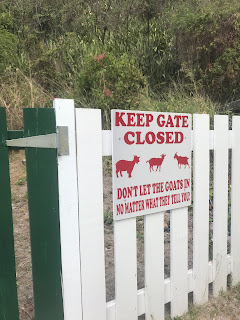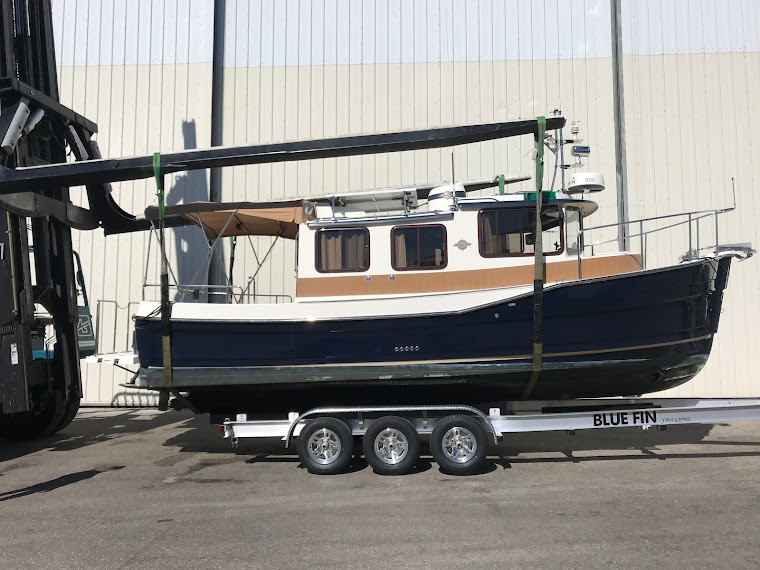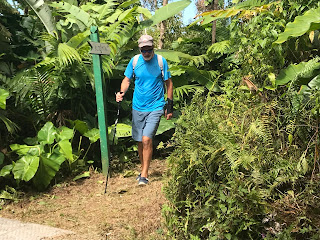Our
Second Volcanic island – Saint Eustatius - Statia
A
short run from Saba brought us to Statia as Saint Eustatius is known.
It is another
independent island country under the Dutch umbrella, but one with more level
land area than Saba. Statia has several
volcanic structures joined by relatively flat land. This small island nation has a special
relationship with the United States since it was the first to recognize and
salute our new country back in 1776?
Orangested is the main town and has two
distinct parts – Upper and Lower. The lower town hugs the edge of the harbor
between the water and a prominent cliff. It is joined to the upper town by the
ancient slave road as well as a more modern road for vehicles. Along this thin
strip of lower town are dive operations, restaurants, and a few hotels as well
as the busy harbor where freight is regularly off loaded.
 |
| ruins of lower town recently uncovered |
 |
| old gin house - hotel |
 |
| Restored Warehouses |
The upper town
sprawls up the gentle slope of the volcanic hills. The highlight of the old
part of upper town includes a restored fort perched on the cliff over the
harbor from which that famous salute was fired to recognize the US ship. This
formal salute may have been an unintended action and one that eventually drew
the wrath of Great Britain, in the end it forged a long-lasting friendship with
the young United States that has persisted over the years. The airport is named
after one of the Roosevelts
 |
| entrance to old slave road |
Statia
sees far fewer tourists than many of the islands we have visited. There is a
large fuel depot operation which seems to sustain the economy more than the
tourism. There are two small hotels in lower town – the boutique Old Gin House
Inn and the Orange Hotel. Both seemed to
cater to the divers who kept the two dive operators busy. Steve was also able to get a dive in and saw
the Grand Canyon – reputed to be the best dive site on the island. (Not up to Saba but close!)
Our
big excursion on Statia was the hike up the Quill – a part of the national park
system on the island. This trail was not as manicured as our hike on Saba, nor
was it as steep or as long. (This is probably why far more hikers on this trail
than on our hike up Saba.) Steve also ventured down into the crater which
Julia’s knees refused to do. The views from the rim were worth the effort as
was the walk through the rainforest portion of this volcano in the cloud.
 |
| land crabs on the path |
 |
| down in the crater |
A
highlight of our walk was meeting Brooks, a lovely lady who offered a lift to
the start of the track with a stop to tour her garden. She is a transplant from Dominica and has a
major green thumb. Interestingly most of
her garden is in raised planters or pots – she was transporting soil from the
lower areas to enrich her planting medium.
A
few boats did join us in the anchorage each night – we spent a week here – but
most only stayed overnight or two days at most.
Why so long in this tiny island country? Well Mother Nature dictates
often our schedule and then sometimes it is a problem with the boat. The anchorages at both Saba and Statia were
rolly so we deployed our flopper stopper to ease the roll. For some reason she took to tangling herself
and twisted up enough to bend some of the essential parts resulting in a
failure of the flopping blades! We did
not want to leave if we could get repairs done in Statia and also we had a
great deal of seven nights in the harbor for a mere $30! So Steve made several trips to the local
hardware store and managed to make friends who had friends in the fuel depot
machine shop. Needless to say, our
flopper is back in business thanks to the help of Terry and Steve’s ingenuity.
Since
Statia has an easy and handy dinghy dock we managed to visit both parts of town
and tried several of the restaurants.
The Harbor Club porch was a favorite for the good eats, breeze and view.
They also provided the largest loaf of bread we have ever seen and chocolate
croissants. Local food was tasted at Franky’s in upper town – recommended by
the dive master. Iced Cappuccino at Para
Mira was a reward for the hike up the old slave road. Statia is not a shopping
stop – we found one cute shop in the lower town – more notable for the building
in which it was located – twin restored old warehouses put to modern uses.
However, a week here flew by away from the more touristy bustle of some of our
previous stops. For the laid back authentic Caribbean experiences, we can highly recommend
both Saba and Statia.














































